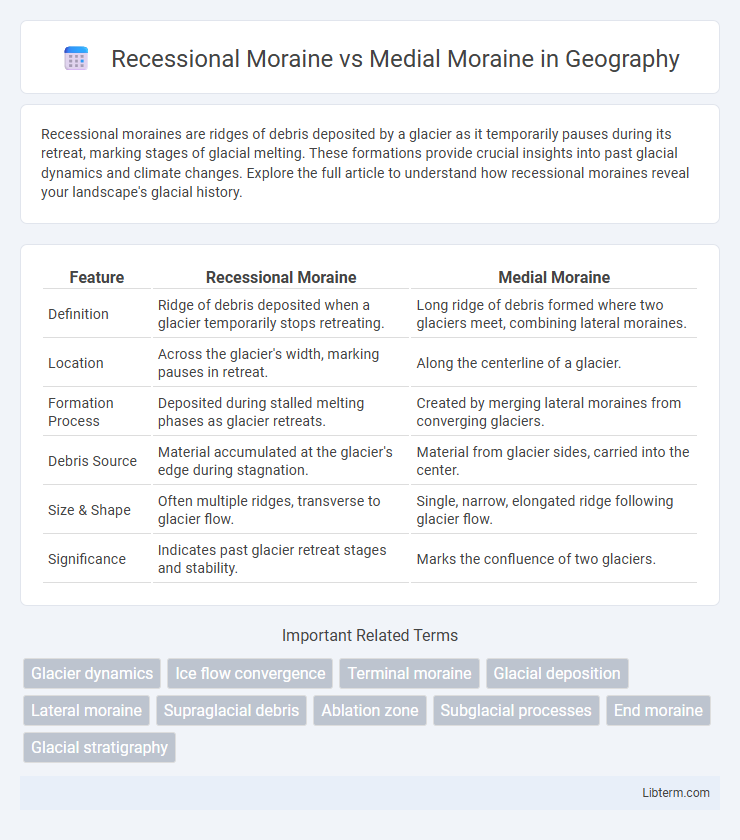Recessional moraines are ridges of debris deposited by a glacier as it temporarily pauses during its retreat, marking stages of glacial melting. These formations provide crucial insights into past glacial dynamics and climate changes. Explore the full article to understand how recessional moraines reveal your landscape's glacial history.
Table of Comparison
| Feature | Recessional Moraine | Medial Moraine |
|---|---|---|
| Definition | Ridge of debris deposited when a glacier temporarily stops retreating. | Long ridge of debris formed where two glaciers meet, combining lateral moraines. |
| Location | Across the glacier's width, marking pauses in retreat. | Along the centerline of a glacier. |
| Formation Process | Deposited during stalled melting phases as glacier retreats. | Created by merging lateral moraines from converging glaciers. |
| Debris Source | Material accumulated at the glacier's edge during stagnation. | Material from glacier sides, carried into the center. |
| Size & Shape | Often multiple ridges, transverse to glacier flow. | Single, narrow, elongated ridge following glacier flow. |
| Significance | Indicates past glacier retreat stages and stability. | Marks the confluence of two glaciers. |
Introduction to Glacial Moraines
Recessional moraines form as glaciers temporarily stabilize during their retreat, leaving ridges of debris that mark former ice margins. Medial moraines occur when two glaciers converge, combining lateral moraines into a central ridge along the glacier surface. Both recessional and medial moraines serve as key indicators of glacial movement and melting patterns in glaciology.
Defining Recessional Moraine
Recessional moraine forms at the paused positions of a retreating glacier, marking temporary halts in its backward movement. It consists of ridges composed of debris deposited as the glacier melts, distinct from the continuous lateral or terminal moraines. Medial moraine, in contrast, forms along the center of a glacier where two glaciers merge, accumulating debris carried from the sides of converging ice flows.
Understanding Medial Moraine
Medial moraines form when two glaciers converge, causing debris from their lateral moraines to combine and create a ridge along the glacier's center. This feature differs from recessional moraines, which mark positions where a glacier temporarily halted during its retreat, resulting in ridges perpendicular to ice flow. Understanding medial moraines provides insight into glacier dynamics and past ice movement patterns.
Formation Processes: Recessional vs Medial Moraines
Recessional moraines form during periods of glacier retreat when the ice margin temporarily stabilizes, causing debris to accumulate at the glacier's terminus. Medial moraines develop where two glaciers converge, merging their lateral moraines into a single line of debris that is carried along the center of the combined glacier. The key difference lies in their formation: recessional moraines mark pauses in glacial retreat, while medial moraines result from the merging of debris from adjacent glaciers.
Key Differences Between Recessional and Medial Moraines
Recessional moraines form at the temporary halts in a glacier's retreat, marking past positions of the glacier's terminus, while medial moraines develop along the center of a glacier from the merging of lateral moraines of converging glaciers. Recessional moraines consist mainly of unsorted glacial debris deposited during pauses in a glacier's retreat, contrasting with medial moraines that contain debris transported within the glacier and exposed on its surface. The spatial location distinguishes them as recessional moraines appear transverse to glacier flow at glacier margins, whereas medial moraines run longitudinally along the glacier's centerline.
Geographical Occurrence and Distribution
Recessional moraines form at the temporary halting points of a glacier's retreat, typically found in regions with fluctuating glacial activity such as the Alps and the Rocky Mountains. Medial moraines occur when two glaciers merge, creating a central moraine that runs down the length of the combined glacier, commonly observed in large ice masses like the Himalayas and the Antarctic Peninsula. The distribution of recessional moraines is often patchy and aligned perpendicular to glacier flow, whereas medial moraines extend longitudinally along the glacier's surface.
Visual Characteristics and Identification
Recessional moraines appear as distinct ridges perpendicular to glacier flow, marking former glacier pauses, with well-defined, sharp crests formed by sediment accumulation at the glacier's retreat stages. Medial moraines manifest as long, linear debris bands running down the glacier's center, created by the merging of lateral moraines from converging glaciers, characterized by a darker debris strip contrasting against the ice surface. Identification of recessional moraines depends on their isolated ridge patterns on valley floors behind the main terminal moraine, while medial moraines are identified by continuous, linear debris features atop active glacier ice.
Importance in Glacial Landform Studies
Recessional moraine and medial moraine are critical features for interpreting past glacier dynamics and sedimentary processes in glacial landform studies. Recessional moraines mark temporary halts in glacier retreat, providing chronological markers for reconstructing glacier retreat rates and climatic fluctuations. Medial moraines reveal the merging of ice streams and sediment transport within glacier interiors, offering insights into glacier flow patterns and ice mass balance.
Case Studies: Notable Examples Worldwide
Recessional moraines, such as those found in the Glacier National Park in Montana, mark pauses in glacial retreat and provide key insights into past climatic conditions. Medial moraines, prominently displayed in the Baltoro Glacier in Pakistan, form from the merging of lateral moraines and reveal glacier flow dynamics. Case studies from the Alps and Patagonia also highlight how these moraine types contribute to understanding glacial morphology and environmental change globally.
Conclusion: Implications for Glacial Geology
Recessional moraines mark pauses in glacier retreat, revealing episodic glacier thinning and contributing to understanding glacier dynamics over time. Medial moraines, formed by the merging of lateral moraines, provide insights into ice flow patterns and glacier confluence zones. Together, these moraines serve as key indicators in reconstructing past glacial environments and assessing sediment transport processes in glacial geology.
Recessional Moraine Infographic

 libterm.com
libterm.com